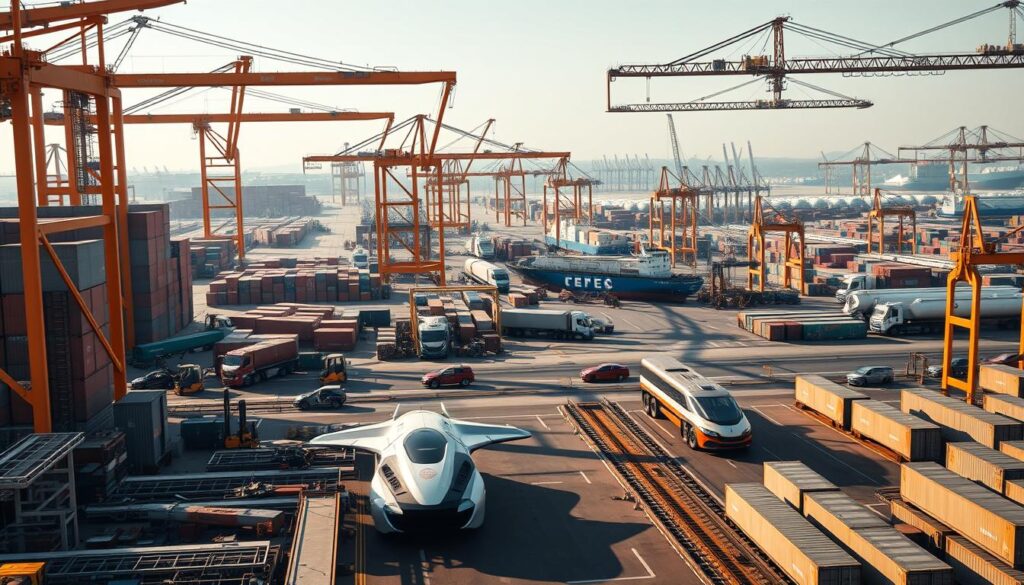Can a well-planned transportation system really make a difference in a company’s bottom line? The answer lies in understanding the importance of multimodal transport design in today’s logistics landscape.
Efficiently utilizing various modes of transportation is not just a financial necessity, but it can also give companies a competitive advantage. By streamlining operations, reducing costs, and enhancing supply chain resilience, businesses can stay ahead in the market.
Effective logistics optimization is crucial for companies to succeed in today’s fast-paced business environment.
Key Takeaways
- Efficient multimodal transportation can give companies a competitive advantage.
- Streamlining operations and reducing costs are key benefits of multimodal transport design.
- Enhancing supply chain resilience is crucial for businesses to stay ahead.
- Logistics optimization plays a vital role in a company’s success.
- A well-planned transportation system can make a significant difference in a company’s bottom line.
Understanding Multimodal Transport
Understanding multimodal transport is essential for developing sustainable transport solutions that meet the diverse needs of travelers and the transportation of goods.
Multimodal transport involves the integration of different modes of transportation, such as road, rail, air, and sea, to create an efficient and seamless journey or supply chain. This approach is critical in today’s interconnected world, where the demand for flexible and reliable transportation options is on the rise.
Definition and Importance
Multimodal transport refers to the use of multiple modes of transportation to move people or goods from one place to another. This approach is important because it offers flexibility, reduces costs, and increases the efficiency of the transportation process. By combining different modes, such as using rail for long-distance transport and road for last-mile delivery, multimodal transport can significantly improve supply chain management.
The importance of multimodal transport lies in its ability to provide sustainable transport solutions that are environmentally friendly and economically viable. As the world grapples with the challenges of climate change and urbanization, multimodal transport offers a way to reduce carbon emissions and improve air quality by optimizing the use of different transportation modes.
Key Components of Multimodal Transport
The key components of multimodal transport include infrastructure, technology, and coordination among different stakeholders. Infrastructure refers to the physical elements that support transportation, such as roads, rails, ports, and airports. Technology plays a crucial role in managing and optimizing multimodal transport systems, through tools like transportation management systems and data analytics.
Coordination among stakeholders, including government agencies, private operators, and users, is vital for the success of multimodal transport. This involves planning, implementing, and managing different modes of transportation in a way that is efficient, safe, and responsive to user needs. For more information on multimodal planning, refer to resources such as multimodal planning documents.
Effective intermodal transportation requires a deep understanding of these components and how they interact. By integrating different modes and managing them as a cohesive system, multimodal transport can provide significant benefits in terms of cost, efficiency, and sustainability.
The Evolution of Transport Systems
The evolution of transport systems has been a gradual process, influenced by historical events, technological advancements, and changing societal needs. Understanding this evolution is crucial for effective transportation planning and logistics optimization.
Historical Context
Historically, transport systems were designed with a focus on basic mobility needs. Before 1950, walking, bicycling, and public transit were recognized as important travel modes. However, transport planning became increasingly automobile-oriented, shifting the focus away from multimodal transport. This historical context is essential for understanding the current state of transport systems and the need for more balanced transportation network engineering.
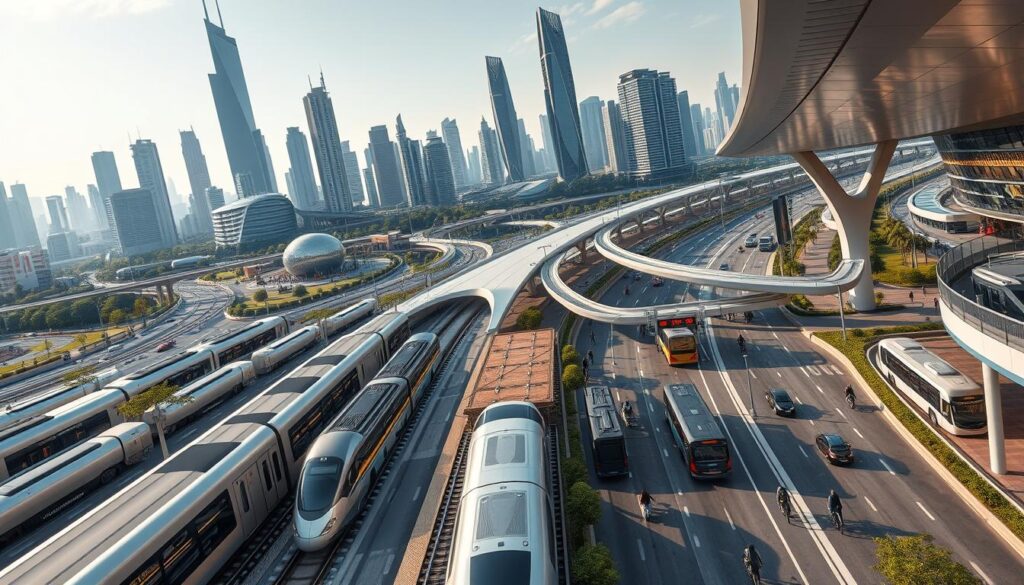
Technological Advancements
Technological advancements have played a significant role in shaping modern transport systems. Innovations in vehicle technology, infrastructure design, and traffic management have improved efficiency and safety. For instance, advancements in logistics optimization have streamlined supply chains, reducing costs and environmental impact.
- Improved vehicle technology
- Advanced infrastructure design
- Smart traffic management systems
Current Trends in Transport Design
Current trends in transport design emphasize the importance of connectivity planning and multimodal transport. There is a growing recognition of the need for sustainable, efficient, and user-friendly transport systems. This includes integrating different modes of transport, such as rail, road, and public transit, to create seamless travel experiences.
| Mode of Transport | Benefits | Challenges |
|---|---|---|
| Rail Transport | Efficient for long distances, environmentally friendly | High initial infrastructure costs |
| Road Transport | Flexible, widespread network | Traffic congestion, environmental impact |
| Public Transit | Reduces private vehicle use, cost-effective | Needs efficient planning and management |
Benefits of Multimodal Transport Design
Effective multimodal transport design is crucial for modern logistics, offering significant advantages in cost, environment, and efficiency. By integrating various transport modes, businesses can create a more streamlined and sustainable logistics operation.
Cost Effectiveness
One of the primary benefits of multimodal transport design is its cost effectiveness. By optimizing routes and modes of transport, companies can significantly reduce their transportation costs. For instance, combining rail and road transport can be more economical than relying solely on trucking.
| Transport Mode | Cost per Tonne | Transit Time |
|---|---|---|
| Rail | $0.05 | 5 days |
| Road | $0.10 | 3 days |
| Multimodal (Rail + Road) | $0.07 | 4 days |
Environmental Impact
Multimodal transport design also has a positive environmental impact. By consolidating freight and using more fuel-efficient modes of transport, such as rail or sea, companies can significantly reduce their carbon footprint. This not only helps in complying with environmental regulations but also enhances the company’s sustainability image.
Freight consolidation is a key strategy in reducing environmental impact. By combining shipments, companies can reduce the number of trips required, thus lowering emissions.
Improved Supply Chain Efficiency
Lastly, multimodal transport design improves supply chain efficiency. By having multiple transport options, businesses can respond more quickly to changes in demand or disruptions in the supply chain. This flexibility is crucial in today’s fast-paced global market.
- Enhanced flexibility in routing and scheduling
- Improved reliability through diversified transport options
- Better risk management through multiple transport modes
In conclusion, multimodal transport design offers numerous benefits, including cost effectiveness, reduced environmental impact, and improved supply chain efficiency. As the logistics industry continues to evolve, embracing multimodal transport solutions will be key to staying competitive and sustainable.
Major Challenges in Multimodal Transport
Multimodal transport is fraught with challenges, particularly in coordinating different transport modes and dealing with infrastructure limitations. Effective intermodal transportation requires seamless integration of various transport modes, including road, rail, air, and sea.
Coordination Among Different Modes
One of the primary challenges in multimodal transport is the coordination among different transport modes. This involves logistics optimization to ensure that goods are moved efficiently from origin to destination.
The complexity of coordinating different modes can lead to delays and increased costs. For instance, a delay in one mode can have a ripple effect, impacting the entire supply chain. To mitigate this, supply chain management practices are crucial.
| Mode | Coordination Challenges | Potential Solutions |
|---|---|---|
| Road | Traffic congestion, road conditions | Real-time traffic monitoring, infrastructure upgrades |
| Rail | Scheduling conflicts, capacity constraints | Advanced scheduling systems, capacity planning |
| Air | Security checks, weather conditions | Streamlined security processes, weather forecasting |
Infrastructure Limitations
Infrastructure limitations pose another significant challenge to multimodal transport. Aging infrastructure, inadequate capacity, and lack of standardization can hinder the efficiency of transport operations.
Investing in infrastructure upgrades and adopting new technologies can help alleviate these challenges. For example, implementing smart infrastructure can enhance logistics optimization and improve overall transport efficiency.

Addressing these challenges requires a collaborative effort among stakeholders, including government agencies, transport operators, and logistics providers. By working together, they can develop effective solutions to enhance the efficiency and reliability of multimodal transport systems.
Essential Elements of Effective Design
The success of multimodal transport design hinges on understanding user needs and preferences. Effective design must consider the diverse requirements of various user groups, ensuring that the transport system is accessible and convenient for all.
User-Centric Approach
A user-centric approach is fundamental to multimodal transport design. It involves understanding the needs and behaviors of different user groups, including commuters, freight operators, and pedestrians. By prioritizing user needs, transport planners can create systems that are more efficient and appealing. For instance, connectivity planning can be enhanced by ensuring that different modes of transport are well-integrated, making it easier for users to switch between them.
Flexibility and Adaptability
Flexibility and adaptability are crucial in multimodal transport design, allowing systems to respond to changing user needs and external factors such as technological advancements or shifts in consumer behavior. A flexible transport system can accommodate different scenarios, from increased demand to unexpected disruptions. This can be achieved through modular design and scalable infrastructure, enabling transport systems to evolve over time.
By incorporating flexibility and adaptability into transport design, planners can create systems that are more resilient and better equipped to handle future challenges. This approach also supports sustainable development by reducing the need for extensive renovations or new constructions.
Regulatory Framework and Compliance
A comprehensive understanding of the regulatory landscape is essential for logistics optimization in multimodal transport. The regulatory framework governing multimodal transport is complex, involving various national and local regulations, as well as safety standards that must be adhered to.
Compliance with these regulations is not only mandatory but also crucial for the smooth operation of multimodal transport systems. It ensures that all stakeholders are on the same page, working towards a common goal of efficient and safe transport.
National and Local Regulations
National and local regulations play a significant role in shaping the multimodal transport landscape. These regulations can vary significantly from one jurisdiction to another, making compliance a challenging task.
For instance, regulations regarding intermodal transportation might differ between countries or even between states within the same country. It is essential for transport operators to be aware of these regulations to avoid legal repercussions and operational disruptions.
“The complexity of regulatory compliance in multimodal transport necessitates a proactive approach to understanding and adhering to the myriad regulations that govern this sector.”
Safety Standards
Safety standards are another critical aspect of the regulatory framework for multimodal transport. These standards are designed to ensure the safety of goods, passengers, and personnel involved in transport operations.
Adhering to safety standards not only helps in preventing accidents but also contributes to the overall efficiency of the transport system. It is crucial for transport operators to implement robust safety protocols and conduct regular safety audits.
| Regulatory Aspect | Description | Importance |
|---|---|---|
| National Regulations | Governs transport operations at a national level | High |
| Local Regulations | Specific to local jurisdictions, may include zoning laws and traffic regulations | High |
| Safety Standards | Ensures the safety of goods, passengers, and personnel | Critical |
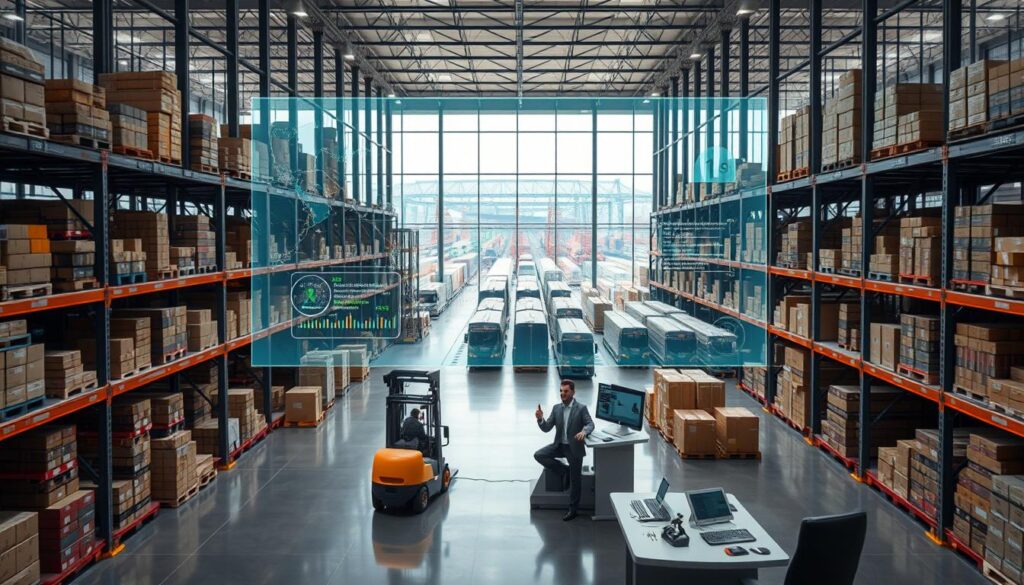
In conclusion, compliance with the regulatory framework, including national and local regulations and safety standards, is vital for the success of multimodal transport operations. It not only ensures legal compliance but also contributes to sustainable transport solutions by minimizing risks and enhancing operational efficiency.
Role of Technology in Multimodal Transport
The integration of technology is revolutionizing multimodal transport design by enhancing efficiency, reducing costs, and improving supply chain management. Technology plays a vital role in optimizing the various components of multimodal transport, ensuring that goods and people move seamlessly across different modes of transport.
Data Analytics and Optimization
Data analytics is a crucial aspect of transportation planning, enabling the analysis of vast amounts of data to identify trends, optimize routes, and predict potential disruptions. By leveraging data analytics, transport planners can make informed decisions that improve the overall efficiency of multimodal transport systems.
The use of data analytics in multimodal transport involves the collection and analysis of data from various sources, including traffic patterns, weather conditions, and logistics data. This information is then used to optimize routes, reduce congestion, and improve supply chain management.
| Benefits of Data Analytics | Description |
|---|---|
| Improved Route Optimization | Data analytics helps in identifying the most efficient routes, reducing travel time and costs. |
| Enhanced Supply Chain Management | By analyzing logistics data, companies can better manage their supply chains, reducing delays and improving delivery times. |
| Predictive Maintenance | Data analytics enables predictive maintenance, reducing the likelihood of equipment failures and minimizing downtime. |
Use of IoT and Smart Solutions
The Internet of Things (IoT) is transforming multimodal transport by enabling real-time monitoring and tracking of goods and vehicles. IoT devices can be used to monitor temperature, humidity, and other environmental factors that may affect the condition of goods during transport.
Smart solutions, such as intelligent transportation systems (ITS), are also being implemented to improve the efficiency of multimodal transport. These systems use advanced technologies, including IoT and data analytics, to optimize traffic flow, reduce congestion, and improve safety.
For more information on how technology is transforming industries, visit this article on AI in civil, which highlights the broader impact of technological advancements on infrastructure and transport.
Case Studies of Successful Designs
The success of multimodal transport designs can be seen in various urban and freight transportation projects worldwide. These case studies demonstrate the effectiveness of integrating different transport modes to achieve logistics optimization and improve overall efficiency.
Urban Transport Solutions
Urban transport solutions have greatly benefited from multimodal transport designs. For instance, cities like Singapore and Copenhagen have implemented comprehensive public transport systems that integrate buses, trains, and cycling infrastructure. These cities have seen a significant reduction in congestion and emissions.
A notable example is Singapore’s intermodal transportation system, which seamlessly connects different modes of transport, making it easy for commuters to travel across the city. The system includes a robust MRT network, an extensive bus network, and dedicated cycling paths.
“The key to successful urban transport is not just about moving people from one place to another, but about creating a livable, sustainable, and connected city.” – Transport Expert
Freight Transportation Case Studies
Freight transportation has also seen significant improvements through multimodal transport designs. The use of freight consolidation centers has become a common practice, allowing for more efficient logistics and reduced costs.
For example, the Port of Rotterdam has implemented an advanced intermodal transportation system that connects sea, rail, and road transport. This has enabled faster and more efficient movement of goods across Europe.
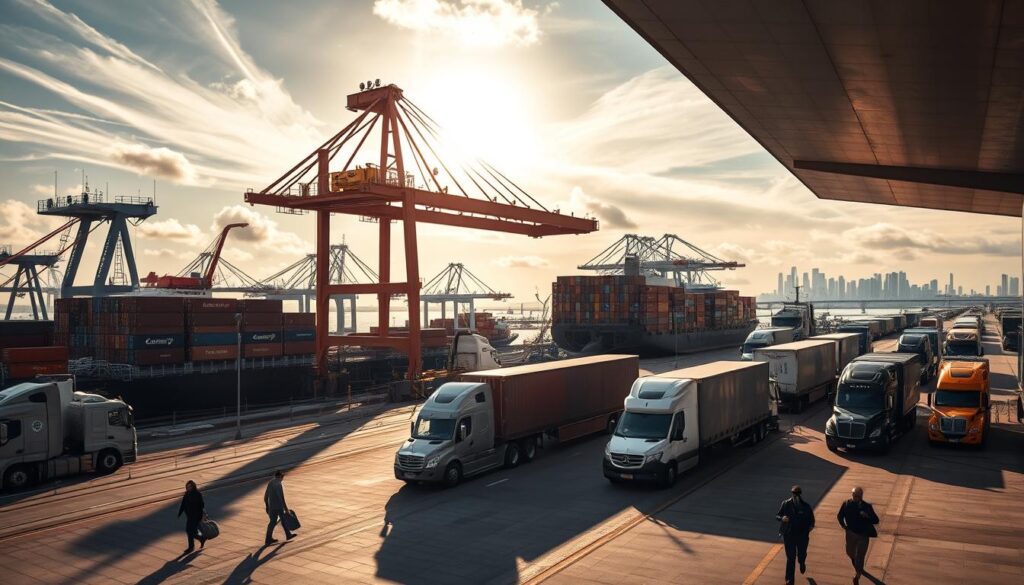
The benefits of such systems include reduced transit times, lower costs, and decreased environmental impact. These case studies highlight the importance of well-designed multimodal transport systems in both urban and freight transportation contexts.
- Improved efficiency through integrated transport modes
- Reduced costs due to optimized logistics
- Environmental benefits from decreased congestion and emissions
By examining these successful designs, we can identify best practices and areas for improvement in multimodal transport systems. This knowledge can be applied to future projects to create even more effective and sustainable transport solutions.
Importance of Collaboration among Stakeholders
The success of multimodal transport design relies heavily on stakeholder collaboration. In the complex landscape of transportation planning, various stakeholders play critical roles that can make or break the efficiency of the system. Effective collaboration ensures that all parties are aligned towards a common goal: creating a seamless, efficient, and sustainable transport network.
Government Agencies
Government agencies are pivotal in shaping the multimodal transport landscape. They are responsible for creating and enforcing regulations, investing in infrastructure, and ensuring that transport systems meet the needs of the population. Regulatory frameworks set by government agencies can either facilitate or hinder the development of multimodal transport. Therefore, it’s crucial that these agencies work closely with other stakeholders to design policies that support integrated transport solutions.
Government agencies can also provide the necessary funding for infrastructure projects. By collaborating with private sector entities, they can leverage public-private partnerships (PPPs) to finance large-scale projects that might be unfeasible with public funds alone.
Private Sector Partnerships
The private sector brings expertise, innovation, and efficiency to multimodal transport projects. Through partnerships with government agencies, private companies can contribute to the development of cutting-edge transport solutions. Technology integration, for instance, is an area where private sector companies can significantly impact, introducing advanced logistics and transport management systems.
Private sector partnerships can also enhance the sustainability of transport systems. Companies specializing in green technologies can collaborate with government agencies to implement environmentally friendly transport solutions, such as electric or hybrid vehicles, and more efficient routing systems.
| Stakeholder | Role in Multimodal Transport | Benefits of Collaboration |
|---|---|---|
| Government Agencies | Regulatory frameworks, infrastructure investment | Effective policies, funded projects |
| Private Sector | Innovation, technology integration, efficiency | Advanced solutions, sustainability |
By fostering collaboration among stakeholders, the transport sector can achieve greater efficiency, sustainability, and user satisfaction. It’s a collaborative effort that requires continuous dialogue and mutual understanding among government agencies, private sector entities, and other stakeholders.
Designing for Sustainability
As the world shifts towards more environmentally conscious practices, designing for sustainability has become a critical aspect of multimodal transport solutions. This shift is driven by the need to reduce the environmental impact of transport systems while maintaining efficiency and effectiveness.
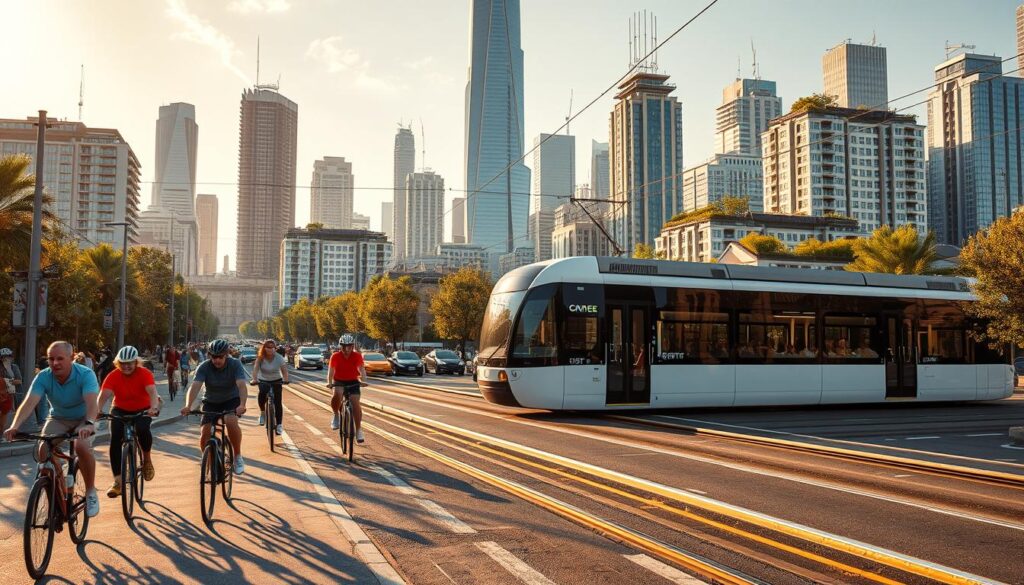
Green Initiatives in Transport Design
Green initiatives are being integrated into transport design to minimize environmental harm. These include the use of renewable energy sources, such as solar and wind power, to fuel transport infrastructure. Additionally, eco-friendly materials are being used in the construction of transport facilities, reducing the carbon footprint of these projects.
Logistics optimization plays a crucial role in sustainable transport design. By streamlining logistics operations, transport systems can reduce congestion and lower emissions. This can be achieved through the use of advanced data analytics and IoT technologies that optimize routes and schedules.
Long-term Sustainability Goals
Setting long-term sustainability goals is essential for the continued development of environmentally friendly transport systems. These goals should include targets for reducing emissions, increasing the use of renewable energy, and promoting sustainable practices throughout the transport sector.
Connectivity planning is also vital for achieving long-term sustainability in transport design. By ensuring that different modes of transport are well-connected, transport systems can reduce the need for personal vehicles, thereby decreasing emissions and promoting more sustainable travel options.
Ultimately, designing for sustainability requires a collaborative approach involving government agencies, private sector entities, and the community. By working together, these stakeholders can develop transport systems that are not only efficient and effective but also environmentally sustainable.
Multimodal Transport and Economic Development
Multimodal transport design plays a crucial role in fostering economic development. By integrating various modes of transportation, cities can enhance connectivity, reduce logistics costs, and improve the overall efficiency of their transport systems.
The economic benefits of multimodal transport are multifaceted. Not only does it facilitate the movement of goods and people, but it also contributes to the growth of local economies by creating jobs and stimulating investment.
Impact on Local Economies
The impact of multimodal transport on local economies is significant. By providing efficient transportation options, businesses can reduce their operational costs, making them more competitive in the global market. This, in turn, can lead to increased economic activity and job creation.
A study on the design of multimodal transport systems highlights the importance of a well-planned infrastructure. According to a report by Nacto.org, effective multimodal transport design can lead to improved economic outcomes for cities.
| Economic Indicator | Impact of Multimodal Transport |
|---|---|
| Job Creation | Increased employment opportunities in logistics and transportation |
| Business Competitiveness | Reduced operational costs enhance global competitiveness |
| Economic Growth | Stimulated investment and increased economic activity |
Job Creation Opportunities
Multimodal transport also plays a vital role in creating job opportunities. From logistics and transportation to maintenance and infrastructure development, the sector provides a wide range of employment opportunities.
Furthermore, the growth of industries related to multimodal transport, such as warehousing and distribution, contributes to job creation. As cities continue to invest in their transport infrastructure, the demand for skilled workers in these areas is likely to increase.
In conclusion, the relationship between multimodal transport and economic development is complex and multifaceted. By understanding the impact of multimodal transport on local economies and job creation, cities can make informed decisions about their transport infrastructure investments.
Future Trends in Multimodal Transport Design
As we look to the future, multimodal transport design is poised to undergo significant transformations driven by technological advancements and changing consumer demands. The integration of innovative technologies and sustainable practices is expected to play a crucial role in shaping the future of transportation systems.
Innovations on the Horizon
Several key innovations are anticipated to impact multimodal transport design significantly. These include:
- Advanced Data Analytics: Enhancing logistics optimization through better demand forecasting and route planning.
- Autonomous Vehicles: Potentially revolutionizing both passenger and freight transport by improving safety and efficiency.
- Sustainable Technologies: Adoption of green technologies to reduce the environmental footprint of transport systems.
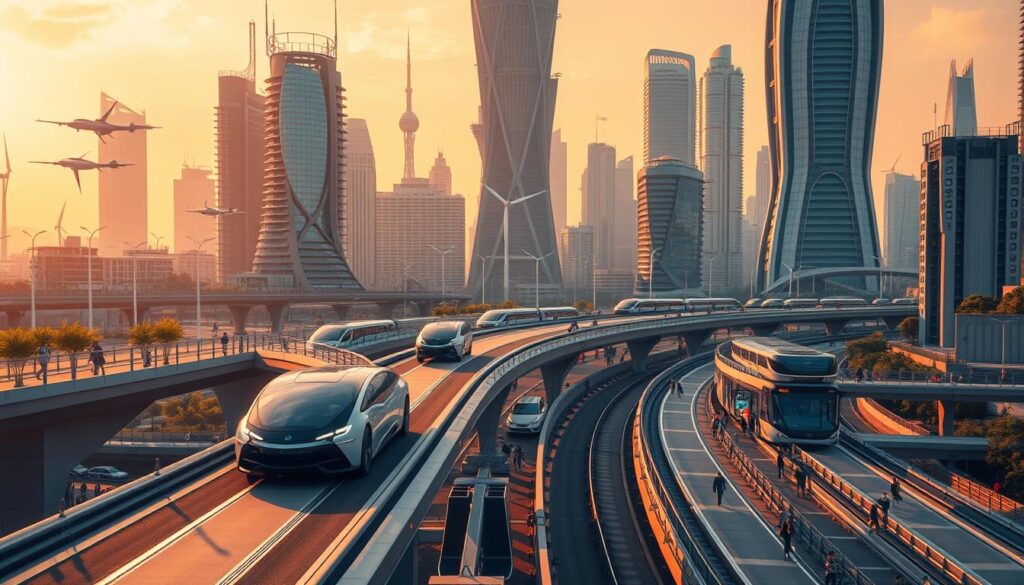
Predicted Changes in Consumer Behavior
Consumer behavior is expected to shift in several key ways, influencing multimodal transport design:
- Increased Demand for Sustainable Options: Consumers are likely to prioritize environmentally friendly transport choices, driving the demand for greener multimodal solutions.
- Greater Expectation for Seamless Travel: With the rise of Mobility-as-a-Service (MaaS), consumers will expect more integrated and user-friendly transport services.
- Enhanced Connectivity: There will be a growing need for better connectivity planning to ensure that transport systems are accessible and efficient.
By understanding these future trends, stakeholders in transportation planning can better prepare for the changes ahead, ensuring that multimodal transport systems are designed to meet future demands effectively.
Engaging with the Community
To create transport systems that truly meet the needs of the population, engaging with the community is essential. Multimodal transport design is not just about integrating different modes of transport; it’s also about understanding the needs and concerns of the people who will be using these systems.
Addressing Public Concerns
One of the critical aspects of community engagement is addressing public concerns. When planning multimodal transport projects, it’s vital to listen to the community’s feedback and worries. This can include concerns about noise pollution, safety, or the impact on local businesses. By actively listening and responding to these concerns, transport planners can design systems that are not only efficient but also acceptable to the community.
Effective community engagement involves transparent communication and inclusive decision-making processes. It’s about creating a dialogue rather than just disseminating information. This approach helps in building trust between the community and the transport authorities.
Gains from Community Feedback
Community feedback is invaluable in shaping sustainable transport solutions. It provides insights into the needs and preferences of the users, which can inform the design of more effective and user-friendly transport systems. Moreover, when communities feel that their voices are heard, they are more likely to support and embrace the changes brought about by new transport initiatives.
The benefits of community engagement extend beyond the planning phase. It can lead to improved supply chain management by identifying the most critical transport needs and bottlenecks. By engaging with the community, transport planners can develop multimodal transport design solutions that are tailored to the specific needs of the area, enhancing overall efficiency and sustainability.
In conclusion, engaging with the community is a cornerstone of successful multimodal transport design. It ensures that the transport solutions developed are not only sustainable and efficient but also meet the needs and expectations of the community they serve.
Designing for Safety and Security
The design of multimodal transport systems requires a meticulous approach to safety and security to mitigate potential risks. As urban streets become increasingly complex, the need for robust safety measures grows.
Assessment of Risk Factors
A critical step in designing for safety and security is the assessment of risk factors. This involves identifying potential hazards associated with different modes of transport and their intersections. For instance, in intermodal transportation, the transfer of goods between different modes (e.g., from truck to train) poses unique risks that need to be mitigated.

By understanding these risks, designers can develop strategies to minimize them, ensuring a safer transport environment. This might involve implementing safety standards that are stringent and universally applied across different transport modes.
Implementing Safety Protocols
Once risk factors are assessed, the next step is to implement safety protocols. This includes developing and enforcing safety standards for both passengers and goods. Effective safety protocols can significantly reduce the incidence of accidents and enhance the overall efficiency of logistics optimization.
For example, regular maintenance of transport infrastructure and vehicles is crucial. Moreover, training personnel in emergency response procedures is vital for ensuring a swift and effective response to any incidents that may occur.
By prioritizing safety and security in multimodal transport design, we can create more resilient and reliable transport systems. This not only protects passengers and goods but also contributes to the overall efficiency of the transport network.
Investment Strategies for Multimodal Projects
Investing in multimodal transport systems demands a comprehensive approach to financing and budgeting. Effective investment strategies are crucial for the development and success of these projects.
Financing Options
There are various financing options available for multimodal transport projects. These include:
- Public-Private Partnerships (PPPs): Collaborations between government agencies and private sector companies to fund and deliver projects.
- Grants and Subsidies: Government grants and subsidies can provide essential funding for infrastructure improvements.
- Loans and Bonds: Financial institutions offer loans, and bonds can be issued to raise capital for large-scale projects.
Each financing option has its advantages and disadvantages. For instance, PPPs can bring in private sector efficiency and investment, while grants and subsidies can reduce the financial burden on governments.
Budgeting for Infrastructure Improvement
Budgeting for infrastructure improvements in multimodal transport projects requires careful planning. It involves:
- Assessing the current state of infrastructure and identifying areas that need improvement.
- Prioritizing projects based on their impact on the overall transport network and economic benefits.
- Allocating funds effectively, ensuring that resources are utilized efficiently.
Effective budgeting also involves monitoring and adjusting plans as necessary to stay within budget and meet project timelines.
By adopting a comprehensive investment strategy that includes a mix of financing options and careful budgeting, multimodal transport projects can achieve their full potential, enhancing supply chain management and overall transportation planning.
Key Takeaways for Effective Multimodal Transport Design
Effective multimodal transport design is crucial for creating sustainable transport solutions that meet the needs of various system users. By integrating transportation and land use, cities can provide diverse mobility options that enhance connectivity planning.
Best Practices Summary
The 5 D’s of Land Use and Transportation – Density, Diversity, Design, Destination accessibility, and Distance to transit – are fundamental principles for effective multimodal transport design. Implementing these principles can lead to improved walkability, vibrant activity centers, and reduced congestion.
Future Development
As cities continue to evolve, it’s essential to prioritize multimodal transport design and connectivity planning. By doing so, we can create more sustainable, equitable, and efficient transport systems that support economic development and improve the quality of life for citizens. Investing in multimodal transport design is key to achieving these goals.
